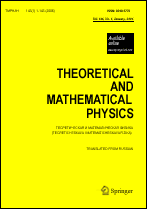|
|
Teoreticheskaya i Matematicheskaya Fizika, 1993, Volume 97, Number 1, Pages 3–26
(Mi tmf1720)
|
|
|
 |
This article is cited in 5 scientific papers (total in 5 papers)
On the statistical derivation of the Schrödinger equation
Yu. L. Klimontovich
M. V. Lomonosov Moscow State University, Faculty of Physics
Abstract:
The transition from reversible microscopic operator equations to irreversible equations for a deterministic density matrix is considered for examples of “simple systems”– the hydrogen atom or a free electron in an electromagnetic field. As a result of the transition, a system of a particle and field oscillators is replaced by a continuous medium. The Schrödinger equation for the deterministic wave function also describes the evolution of a continuum but without allowance for dissipative terms. In this sense, there is an analogy between the Schrödinger equation in quantum mechanics and Euler's equation in hydrodynamics. The smallest size of a “point” of a continuous medium is described by the classical electron radius $r_e$. It also determines the effective Thomson cross section for scattering of photons by free electrons. The length $r_e$ and the corresponding time interval $\tau _e=r_e/c$ play the role of “hidden parameters” in quantum mechanics. Two methods of calculating the effective Thomson cross section in terms of the extinction coefficient are considered. The first of them is based on the equation of motion of a free electron in a field with allowance for radiative friction. This equation leads to well-known difficulties. Moreover, the velocity fluctuations calculated on its basis lead to a contradiction with the second law of thermodynamics. The second method is based on the introduction of a constant friction coefficient $\Gamma =\tau _e^{-1}$, the presence of which reflects loss of information on smoothing over the volume of a “ point” of the continuous medium. Such a method of calculation leads to the same expression for the effective cross section but makes it possible to avoid the difficulties with the second law of thermodynamics. In the derivation of quantum kinetic equations, the physically infinitesimally small scales are determined by the Compton length $\lambda _C$ and the corresponding time interval. The introduction of these scales makes it possible to separate and eliminate small-scale fluctuations, the “collision integrals” being expressed in terms of the correlation functions of these fluctuations.
By considering examples of the “simple quantum systems”: a hydrogen atom or a free electron in a microscopic electromagnetic field, the transition from reversible microscopic operator equations to irreversible equations for the deterministic matrix density is studied. As a result of this transition the microscopic system of particle and electromagnetic oscillators is replaced by a continuous medium. Schrödinger equation for a deterministic wave function also describes an evolution of a continuous medium but without dissipative terms. In this sense an analogy between Schrödinger equation in quantum mechanics and Euler equations in a hydrodynamics exists. The smallest size of a continuous medium “point” is defined by the classical electron radius $r_e$. It defines also Tomson effective cross-section for a photon scattering by free electrons. The length $r_e$ and the corresponding time interval
$r_e$ play the role of “hidden psrameters” in quantum mechanics. Two methods of defining Tomson cross section via the extinction coefficient are presented. The first one is based on the free electron motion equation with the radiation friction is taken into account. This equation leads to the known difficulties. Moreover, the contradiction between calculations for electron velocity fluctuations and the second thermodynamics law appears. The second one is based on the equation of motion with constant friction coefficient. It reflects the loss of information in process of smoothing over the volume of the continuous medium point. This method leads to the same expression for the cross section, but allows one to avoid contradictions with the second law of thermodynamics. The smoothing over the volume $r_e^3$ is used only on the first stage of the transition to the irreversible equations. Deriving a kinetic equation – the dissipative closed equation for one particle density matrix, physically infinitesimal scales are defined by the Compton length $\lambda _C$ and by corresponding time interval $\tau _C=\lambda _C/c$. Such a definition of a point allows one to exclude the small scale fluctuations, whose correlator defines the corresponding “collision integral”.
Received: 07.07.1993
Citation:
Yu. L. Klimontovich, “On the statistical derivation of the Schrödinger equation”, TMF, 97:1 (1993), 3–26; Theoret. and Math. Phys., 97:1 (1993), 1111–1125
Linking options:
https://www.mathnet.ru/eng/tmf1720 https://www.mathnet.ru/eng/tmf/v97/i1/p3
|


| Statistics & downloads: |
| Abstract page: | 769 | | Full-text PDF : | 298 | | References: | 70 | | First page: | 3 |
|




 Contact us:
Contact us: Terms of Use
Terms of Use
 Registration to the website
Registration to the website Logotypes
Logotypes







 Citation in format
Citation in format 
